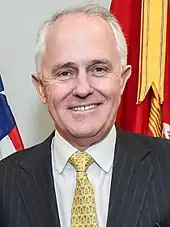1998 Australian Constitutional Convention
The 1998 Australian Constitutional Convention was a Constitutional Convention which gathered at Old Parliament House, Canberra from 2 to 13 February 1998. It was called by the Howard Government to discuss whether Australia should become a republic. The convention concluded with "in principle support" for an Australian republic (with a dissenting minority voting for a continuation of the Australian constitutional monarchy) and proposed a model involving appointment of the head of state by Parliament.[1] The model was put to a referendum in November 1999 and rejected by the Australian electorate.
| 1998 Australian Constitutional Convention | |
|---|---|
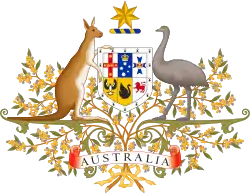 | |
| Status | Defunct |
| Genre | Constitutional Convention |
| Begins | 2 February 1998 |
| Ends | 13 February 1998 |
| Venue | Old Parliament House |
| Location(s) | Parkes, Canberra |
| Country | Australia |
| People | The Right Honourable Ian Sinclair MP (Co-chair); The Honourable Barry Jones AO MP (Co-chair) |
Background
Australia remains a constitutional monarchy under the Australian Constitution adopted in 1901, with the duties of the head of state performed by a Governor-General selected by the Australian Prime Minister. Australian republicanism has persisted since colonial times, though for much of the 20th century, the monarchy remained popular. In the early 1990s, republicanism became a significant political issue. Australian Labor Party Prime Minister Paul Keating indicated a desire to instigate a republic in time for the Centenary of the Federation of Australia in 2001. The opposition Liberal-National Coalition, led by Alexander Downer, though less supportive of the republic plan, promised to convene a Constitutional Convention to discuss the issue. Under John Howard, the Coalition won the 1996 Federal Election and set the Convention date for February 1998.[2]
Composition
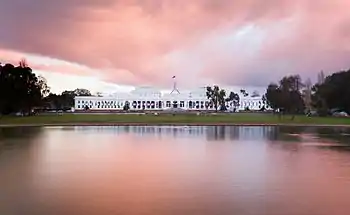
The convention comprised 152 delegates from all of the states and territories of Australia – half elected by voluntary postal vote and half appointed by the federal government. Of the appointees, 40 were representatives of the commonwealth, state and territory parliaments. Various pro-republican and pro-monarchy delegates were elected and various parliamentary and non-parliamentary delegates were appointed including state and territory leaders. The convention was chaired by the Right Honourable Ian Sinclair MP, of the National Party of Australia with the Honourable Barry Jones AO MP of the Australian Labor Party as deputy chairman.[3]
Parliamentarians
Sitting members of the Liberal-National Party Coalition were permitted a free vote on the republican issue, while the Australian Labor Party (ALP) adopted the republican position as a matter of party policy. Senior Liberals split on the issue, with the Prime Minister, John Howard, supporting the status quo and the Treasurer, Peter Costello, supporting a republic.[2] Other representatives of the government at the convention included the Attorney General, Daryl Williams, the Minister for the Environment, Robert Hill, and the Minister for Social Security, Jocelyn Newman, as well as the Deputy Prime Minister, Tim Fischer, and other Members of Parliament. The Leader of the Opposition, Kim Beazley, was accompanied by colleagues Gareth Evans, John Faulkner and others, while the Australian Democrats sent Senator Natasha Stott Despoja.
The states all sent three representatives including their premiers and opposition leaders, while the territories were represented by their chief ministers.[3] Premiers Bob Carr (New South Wales), Jeff Kennett (Victoria), Rob Borbidge (Queensland), Richard Court (Western Australia), John Olsen (South Australia) and Tony Rundle (Tasmania) attended, along with chief ministers Kate Carnell (Australian Capital Territory) and Shane Stone (Northern Territory).
ARM and ACM
A number of members of the Australian Republican Movement (ARM) attended the convention. ARM was established in July 1991 and comprised distinguished Australian intellectuals, politicians and former politicians, business people, students and other citizens who supported an Australian republic. A number of Australian Labor Party supporters and members were attracted to the organisation, though its leader from 1993 to 2000 was future Liberal Prime Minister Malcolm Turnbull.[2][4] Prominent delegates at the Convention included media personalities Steve Vizard and Eddie McGuire, businesswoman Janet Holmes à Court and businessman Lindsay Fox.[1]
Australians for Constitutional Monarchy was established in 1992, after Prime Minister Keating announced his republican agenda. The organisation was called together to counter the republican movement by Justice Michael Kirby and like minded constitutional monarchists including Lloyd Waddy QC, Aboriginal statesman Neville Bonner, Chancellor of the University of Sydney Dame Leonie Kramer, Helen Sham-Ho (the first Chinese-born member of an Australian Parliament), Doug Sutherland (former Labor Lord Mayor of Sydney) and others.
Later, former Labor leader and Governor General Bill Hayden joined the organisation and membership grew to more than 30,000 registered supporters nationwide. Justice Kirby argued that a constitutional monarchy is "a system of government for those committed to effective checks on rulers and to liberal democracy". Kirby resigned from the organisation upon being appointed a judge of the High Court of Australia and did not participate in the Convention. ACM recruited Tony Abbott as its first full-time executive director, although his membership also ceased following pre-selection as a Liberal candidate for election to the Federal Parliament in March 1996. Kerry Jones was then appointed executive director of ACM in his place. She and Lloyd Waddy led ACM through the 1998 Constitutional Convention and the 1999 referendum.[2] Don Chipp, founder of the Australian Democrats, was one of ACM's delegates at the Convention.
Others
Smaller republican groupings included "A Just Republic", the "Real Republic" group, the Clem Jones "Queensland Constitutional Republic Team" and the Ted Mack group. Other monarchist groups included the "Constitutional Monarchists" group, the Australian Monarchist League and "Safeguard the People". Other minor Australian political parties with elected representatives included the Shooters Party, the Christian Democrats (Fred Nile Group). A number of individuals were elected under other grouping names, including lawyer Jason Yat-Sen Li ("A Multi-Cultural Voice") and Misha Schubert ("Republic4U – The Youth Ticket").
Six Indigenous delegates participated in the Convention, including magistrate Pat O'Shane, who was vocal in support of a republic and monarchist Neville Bonner, Australia's first Aboriginal parliamentarian, who ended his contribution to the Convention with a Jagera Tribal Sorry Chant in sadness at the deception practised by republicans. The Republican Model, as well as a proposal for a new Constitutional Preamble which would have included the "honouring" of Aboriginals and Torres Strait Islanders.[5]
Lady Florence Bjelke-Petersen and Glen Sheil represented the group named "Constitutional Monarchists", while prominent Returned and Services League spokesman Bruce Ruxton represented the monarchist "Safeguard the People" group and Brigadier Alf Garland represented the Australian Monarchist League. Ted Mack and Phil Cleary were prominent independent republicans.
Clergy from the major churches were appointed as delegates: the Catholic Church in Australia's George Pell and the Anglican Church of Australia' s Peter Hollingworth; while republican Tim Costello, a prominent Baptist minister was elected as a representative for Victoria from the "Real Republic Group".
Other appointees included academics, such as historian Geoffrey Blainey and Sydney University chancellor Leonie Kramer; legal and constitutional experts such as law professor Greg Craven retired judge Richard McGarvie and public servant David Smith. Former Vice Regal office holders were also appointed, including former Governor of South Australia Dame Roma Mitchell and former Governor General Bill Hayden. Senior business appointees included Sir Arvi Parbo and Donald McGauchie. Journalist delegates included Mia Handshin and Miranda Devine.
Debate and conclusions
The Convention debated the need for a change to the Constitution of Australia which would remove the monarchy from a role in Australian government and law. According to the final communiqué issued by the Convention, three questions were considered:[6]
- Whether or not Australia should become a republic; which republic model should be put to the voters to consider against the current system of government; in what time frame and under what circumstances might any change be considered.
Delegates advocated a range of positions from no-change to minimal change to radical change. According to the final communique:
- Three categories of model for a possible Australian republic were before the convention. They were: direct election, parliamentary election by a special majority, and appointment by a special council following prime ministerial nomination.
"In principle" agreement was reached by a majority of delegates for an Australian Republic (though a minority bloc of Monarchists dissented).[1] Following a series of votes, a proposal for a "Bipartisan Appointment of the President Model" for an Australian republic was endorsed by a majority of delegates who voted for or against the motion (monarchists and some radical-change republicans abstained from the vote). According to hansard, the vote for the Bi-Partisan model was: "for" 73, "against" 57 with 22 abstentions.[7]
The final communiqué recommended that Parliament establish a committee responsible for considering the nominations for the position of president and consult widely in the community and compile a shortlist for the Prime Minister. Taking into account the recommendations of the committee, the Prime Minister would then present a single nominee, seconded by the Opposition Leader to a joint sitting of the Australian Parliament which must gain a two-thirds majority in order to be endorsed. The president could be removed at any time by a notice in writing signed by the Prime Minister, however if the House of Representatives failed to ratify this dismissal, the president would be eligible for re-appointment. The powers of the president were to be those of the existing office of Governor General of Australia.[6]
The Convention recommended that state parliaments also examine the issue of the republic, as each state has separate and individual constitutional links to the monarchy. Certain recommendations were made for a new Constitutional preamble which included introductory language along the lines of "we the Australian people", and referencing "Almighty God", custodianship and occupancy of Australia by Indigenous Australians; as well as affirmations of the law, cultural diversity, unique land and environment and democratic political system of Australia.[6]
The new Australian republic was to retain the name Commonwealth of Australia.
The Convention recommended to the Prime Minister and Parliament of Australia that the model, and other related changes to the Constitution, supported by the convention, be put to the people in a constitutional referendum in 1999.[6]
The minimalist McGarvie Model developed by former Governor of Victoria, Richard McGarvie, and originally submitted to the Republic Advisory Committee in 1993, was the second most popular model of the four voted upon. Republican delegates Clem Jones, Ted Mack, Pat O'Shane, Paul Tully and Paddy O'Brien held out for greater change to the Constitution than the more minimalist model ultimately proposed.[8]
Arguments by key advocates

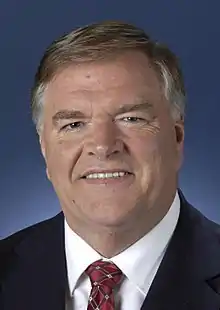
In his address to the opening session of the Convention, Liberal Prime Minister John Howard outlined his support for retaining the status quo on the basis that it has provided a long period of stability and said he believed that the "separation of the ceremonial and executive functions of government" and the presence of a neutral "defender of constitutional integrity" was an advantage in government and that no republican model would be as effective in providing such an outcome as the Australian monarchy:[9]
In my view, the only argument of substance in favour of an Australian republic is that the symbolism of Australia sharing its legal head of state with a number of other nations is no longer appropriate. As a matter of law, Elizabeth II is Queen of Australia. As a matter of indisputable constitutional convention, the Governor-General has become Australia's effective head of state.
It will ultimately be for the Australian people to resolve this theoretical conflict between our history and present day constitutional reality – to decide whether removing the symbolism which many see as inappropriate in our present arrangements – counts more than the stability and inherent strength of the existing order.
I oppose Australia becoming a republic because I do not believe that the alternatives so far canvassed will deliver a better system of government than the one we currently have. I go further – some will deliver a worse outcome and gravely weaken our system of government. I believe that modern government is most workable where the essentially ceremonial functions of government are separated from the day to day executive responsibilities.
— Prime Minister John Howard
The Deputy Prime Minister, Tim Fischer, of the National Party said that the Australian Constitution had delivered one of the "oldest continuous federated democracies in the world" and that changing it would be a complex operation:[10]
The case for changing our mighty Constitution which has helped modernise Australia remains distant, divided and ill-defined. I say: stay with a system that works and works well.
— Deputy Prime Minister Tim Fischer
Opposition Leader Kim Beazley of the Australian Labor Party advocated "minimalist" change. He described transition to a republic as "unfinished business" for Australia and said that foreigners "find it strange and anachronistic, as many Australians now clearly do, that our Head of State is not an Australian". The ALP proposed appointment of a president by two-thirds majority of parliament. In his opening address, Beazley told the Convention:[11]
Our nation is a republic in all but name. We argue that we as a nation should recognise the reality of our small "r" republican arrangements by making the necessary adjustments to place the capping stone on that structure – a Head of State who is unambiguously Australian – a Head of State who is one of us.
— Opposition Leader Kim Beazley
Liberal Treasurer Peter Costello advocated for a republic. He rejected any suggestion that Australia was not already an independent nation and said that, while the Australian Constitution works "remarkably well", it was the institution of monarchy that was the crux of his argument for change:[12]
It is commonly said that all this argument is about is whether we want an Australian as our head of state. If that were all we wanted, one of the options to fix it would be an Australian monarchy but, in truth, the problem is more the concept of monarchy itself. The temper of the times is democratic; we are uncomfortable with an office that appoints people by hereditary. In our society in our time we prefer appointment by merit.
— Treasurer Peter Costello
Pat O'Shane, a magistrate and indigenous woman expressed a desire for change based on what she perceived as historical injustice and present inadequacies within the Australian Constitution:[13]
That modern Australia, the Australia that has developed since 26 January 1788 as distinct from the Australia of my ancestors, has a constitutional monarchy is a direct unambiguous consequence of our origins as a colony of Britain—a penal colony at that. As such, it was underwritten with the values of power, privilege, elitism, oppression and dispossession. It was blatantly exclusionary. It is no wonder then that the Australian Constitution, designed to institute a constitutional monarchy as the system of government in this country, is such an inadequate and uncertain instrument as it is.
— Magistrate Pat O'Shane
Indigenous delegates were divided, however. Former Senator Neville Bonner made an impassioned defence of the constitutional monarchy, describing efforts to change it as "senseless division" and a distraction from the real problems facing Australia:[10]
You [non-indigenous Australians] came to my country. You invaded my land. You took our Earth (our everything). .... And then slowly you began to change ... You began to accept that my people had rights; that they were entitled to respect ...
We have come to accept your laws. We have come to accept your Constitution. We have come to accept the present system. We believed you when you said that a democracy must have checks and balances. We believed you when you said that not all positions in society should be put out for election. We believed you when you said that judges should be appointed, not elected. We believed you when you said that the Westminster system ensures that the government is accountable to the people. We believed you when you taught us that integral to the Westminster system is a head of state who is above politics. We believed you when you said that, as with the judiciary, Government House must also be a political-free zone. We believed you when you said that it is not important that the Crown has greater powers and that what was important was that the Crown denies those powers to the politicians ...
I cannot see the need for change. I cannot see how it will help my people. I cannot see how it will resolve the question of land and access to land that troubles us. I cannot see how it will ensure that indigenous people have access to the same opportunities that other Australians enjoy. Fellow Australians, what is most hurtful is that after all we have learned together, after subjugating us and then freeing us, once again you are telling us that you know better. How dare you?
— Neville Bonner
Kerry Jones, leader of Australians for Constitutional Monarchy defended the Australian Constitution, saying "no republic model will ever offer the protection and safeguards that work so well in our current Constitution". She said her task was to "assess each republican model against the Constitution that has served us so well":[14]
I had become a constitutional monarchist—not out of my love of English blood, for my blood is actually Irish; not out of birth in the Protestant establishment, for I am actually a Catholic; not out of enthusiasm for all things royal, for I have little interest in such trivia. I had become a constitutional monarchist because I was persuaded, as was Michael Kirby, that the system of government bequeathed to us by our founders is superior to any republican models proposed.
— Kerry Jones, Australians for Constitutional Monarchy
Delegates examined various models for a republic. Independent republican delegate Phil Cleary argued the case for direct-election of a president and questioned the motivations of "conservative" republicans:[14]
About the time of the last convention one of our greatest poets, Henry Lawson, claimed that Australians would doff their hat to no man and call no biped master. Now the best the conservative wing of the republican leadership can offer the people is an appointed president—a president palatable to the major parties. Their justification is pure scaremongering ... What are they frightened of? Do they fear a creative tension in the political system, or is it more that they fear giving up their power or their loss of influence?
— Phil Cleary
Malcolm Turnbull, leader of the Australian Republican Movement, cautioned against mixing the roles of President and Prime Minister in a direct election system, telling the Convention:[12]
Mr Clem Jones has proposed a directly elected model that would give the president additional powers. We believe that is not a good option. We feel that a directly elected president should either have no powers—for example, as in Ireland—or be the chief executive of the nation, as in the case of the United States. We think the French arrangement, where executive power is shared in a very confused fashion between the President and the Prime Minister, is the worst of all options. So I would say that we either go to Dublin for a directly elected president or we go to Washington; the Paris option, for the reasons advanced by Mr (Bob) Carr, is not on.
— Malcolm Turnbull, Australian Republican Movement
The Catholic Archbishop of Melbourne, George Pell, supported change, but noted "Without support from most of the front benches of both sides of the parliament, it would be wasteful to go to a referendum." Towards the end of proceedings, he called on conservatives to support change:[7]
All conservatives here should realise that they will never get a better result out of a convention than they have done here. It will certainly be no less difficult for a tyrant to abuse the office of Prime Minister or president. That is fundamental; we all agree. The preamble has been voided of legal significance, the reserve powers are retained and, with partial codification, this will in practice make them stronger because they will become less unpredictable and less offensive.
— George Pell, Archbishop of Melbourne
Aftermath
Two proposals to amend the Australian Constitution were submitted to the Australian electorate in November 1999. If approved, the referendum would have established a republican system of government in Australia. The referendum held on 6 November 1999 failed to achieve the support of either a majority of voters or a majority of states. The national vote of the electors in favour of Australia becoming a republic was 45.13%, with 54.87% against.[15] Australia remains a constitutional monarchy.[2]
Delegates
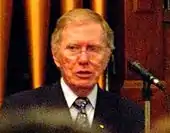





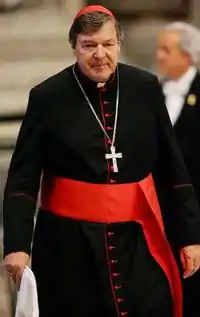

A total of 152 delegates, from each state and territory and a wide diversity of backgrounds, gathered at Old Parliament House in Canberra. Seventy-six of the delegates were elected by a voluntary postal ballot. The other seventy-six were appointed by the federal government.[3]
List of elected delegates
| Order | Delegate name | Organisation | State/Territory |
|---|---|---|---|
| 1 | Malcolm Turnbull | Australian Republican Movement | New South Wales |
| 2 | Doug Sutherland | No Republic – ACM | |
| 3 | Ted Mack | Ted Mack Group | |
| 4 | Wendy Machin | Australian Republican Movement | |
| 5 | Kerry Jones | No Republic – ACM | |
| 6 | Ed Haber | Ted Mack Group | |
| 7 | The Hon. Neville Wran AC QC | Australian Republican Movement | |
| 8 | Cr Julian Leeser | No Republic – ACM | |
| 9 | Karin Sowada | Australian Republican Movement | |
| 10 | Peter Grogan | Australian Republican Movement | |
| 11 | Jennie George | Australian Republican Movement | |
| 12 | Christine Ferguson | No Republic – ACM | |
| 13 | Alasdair Webster | Christian Democratic Party (Fred Nile Group) | |
| 14 | Glenda Hewitt | ungrouped – I Care About Australia's Future | |
| 15 | Dr Pat O'Shane AM | A Just Republic | |
| 16 | Brigadier Alf Garland AM | Australian Monarchist League | |
| 17 | Andrew Gunter | Ethos – Elect the Head of State | |
| 18 | Hazel Hawke | Australian Republican Movement | |
| 19 | Jason Yat-Sen Li | ungrouped – A Multi-Cultural Voice | |
| 20 | Catherine Moore | Greens, Bill of Rights, Indigenous Peoples | |
| 21 | Eddie McGuire | Australian Republican Movement | Victoria |
| 22 | The Hon. Don Chipp AO | No Republic – ACM | |
| 23 | The Rev. Tim Costello | Real Republic | |
| 24 | Bruce Ruxton OBE MBE | Safeguard the People | |
| 25 | Mary Delahunty | Australian Republican Movement | |
| 26 | Sophie Panopoulos | No Republic – ACM | |
| 27 | Steve Vizard | Australian Republican Movement | |
| 28 | Poppy King | Australian Republican Movement | |
| 29 | Lindsay Fox AO | Australian Republican Movement | |
| 30 | The Hon. Vernon Wilcox CBE QC | Safeguard the People | |
| 31 | Moira Rayner | Real Republic | |
| 32 | Misha Schubert | Republic4U – The Youth Ticket | |
| 33 | The Hon. Jim Ramsay | No Republic – ACM | |
| 34 | Kenneth Gifford QC | Australian Monarchist League | |
| 35 | Phil Cleary | ungrouped – Phil Cleary – Independent Australia | |
| 36 | Eric Bullmore | Shooters Party | |
| 37 | The Hon. Sir James Killen KCMG | No Republic – ACM | Queensland |
| 38 | Dr Clem Jones | Clem Jones Queensland Constitutional Republic Team | |
| 39 | The Hon. Michael Lavarch | Australian Republican Movement | |
| 40 | Dr Glen Sheil | Constitutional Monarchists | |
| 41 | Neville Bonner AO | No Republic – ACM | |
| 42 | David Muir | Clem Jones Queensland Constitutional Republic Team | |
| 43 | Sallyanne Atkinson AO | Australian Republican Movement | |
| 44 | Thomas Bradley | No Republic – ACM | |
| 45 | Florence, Lady Bjelke-Petersen | Constitutional Monarchists | |
| 46 | Mary Kelly | Women for a Just Republic | |
| 47 | Sarina Russo | Australian Republican Movement | |
| 48 | Cr Paul Tully | Queenslanders for a Republic | |
| 49 | Cr Ann Bunnell | Clem Jones Queensland Constitutional Republic Team | |
| 50 | Janet Holmes à Court | Australian Republican Movement | Western Australia |
| 51 | The Rt Hon. Reg Withers | No Republic – ACM | |
| 52 | Prof. Peter Tannock | Australian Republican Movement | |
| 53 | Geoff Hourn | No Republic – ACM | |
| 54 | Graham Edwards | Australian Republican Movement | |
| 55 | Clare Thompson | Australian Republican Movement | |
| 56 | Marylyn Rodgers | No Republic – ACM | |
| 57 | Liam Bartlett | ungrouped – An Open Mind for the Future | |
| 58 | Prof. Patrick O'Brien | Elect the President | |
| 59 | Kym Bonython | No Republic – ACM | South Australia |
| 60 | Dr Baden Teague | Australian Republican Movement | |
| 61 | The Rt Rev. John Hepworth | No Republic – ACM | |
| 62 | Linda Kirk | Australian Republican Movement | |
| 63 | Victoria Manetta | No Republic – ACM | |
| 64 | Dr Tony Cocchiaro | Australian Republican Movement | |
| 65 | Fr John Fleming | No Republic – ACM | |
| 66 | Kirsten Andrews | Australian Republican Movement | |
| 67 | Edward O'Farrell CVO CBE | No Republic – ACM | Tasmania |
| 68 | Julian Green | Australian Republican Movement | |
| 69 | Michael Castle | No Republic – ACM | |
| 70 | Marguerite Scott | Australian Republican Movement | |
| 71 | Dr David Mitchell | The Australian Monarchist League | |
| 72 | Eric Lockett | ungrouped – Voice of Ordinary, Fair-Minded, Thinking Citizens | |
| 73 | Anne Witheford | Australian Republican Movement | Australian Capital Territory |
| 74 | Frank Cassidy | Australian Republican Movement | |
| 75 | David Curtis | A Just Republic | Northern Territory |
| 76 | Michael Kilgariff | ungrouped – Territory Republican |
List of appointed delegates
| Order | Delegate name | State/Territory | Category |
|---|---|---|---|
| 1 | Andrea Ang | Western Australia | Non-parliamentary |
| 2 | Stella Axarlis | Victoria | |
| 3 | Dannalee Bell | Victoria | |
| 4 | Julie Bishop | Western Australia | |
| 5 | Geoffrey Blainey AO | Victoria | |
| 6 | Greg Craven | Western Australia | |
| 7 | Miranda Devine | New South Wales | |
| 8 | Gatjil Djerrkura OAM | Northern Territory | |
| 9 | Mia Handshin | South Australia | |
| 10 | The Hon. Bill Hayden AC | Queensland | |
| 11 | The Most Revd Peter Hollingworth AO OBE | Queensland | |
| 12 | Mary Imlach | Tasmania | |
| 13 | Major General William James AO MBE MC | Queensland | |
| 14 | Adam Johnston | New South Wales | |
| 15 | Annette Knight AM | Western Australia | |
| 16 | Dame Leonie Kramer AC | New South Wales | |
| 17 | Helen Lynch AM | New South Wales | |
| 18 | The Hon. Richard McGarvie AC | Victoria | |
| 19 | Donald McGauchie AC | Victoria | |
| 20 | The Hon. Dame Roma Mitchell AC | South Australia | |
| 21 | Carl Möller | Tasmania | |
| 22 | Cr Joan Moloney | Queensland | |
| 23 | George Mye MBE AM | Queensland / TSI | |
| 24 | Ben Myers | Queensland | |
| 25 | Moira O'Brien | Northern Territory | |
| 26 | Lois O'Donoghue CBE AM | South Australia | |
| 27 | Sir Arvi Parbo AC | Victoria | |
| 28 | The Most Revd George Pell | Victoria | |
| 29 | Nova Peris-Kneebone | Western Australia / Northern Territory | |
| 30 | Peter Sams | New South Wales | |
| 31 | Judith Sloan | South Australia | |
| 32 | Sir David Smith AM | Australian Capital Territory | |
| 33 | Trang Thomas AM | Victoria | |
| 34 | Lloyd Waddy RFD QC | New South Wales | |
| 35 | George Winterton | New South Wales | |
| 36 | Heidi Zwar | Australian Capital Territory | |
| Order | Delegate name | Office | Category |
| 37 | The Hon. John Howard MP | Prime Minister | Parliamentary |
| 38 | The Hon. Peter Costello MP | Treasurer | |
| 39 | The Hon. Daryl Williams AM QC MP | Attorney-General | |
| 40 | Senator the Hon. Robert Hill | Minister for the Environment | |
| 41 | Senator the Hon. Jocelyn Newman | Minister for Social Security | |
| 42 | Neil Andrew MP | Chief Government Whip | |
| 43 | Chris Gallus MP | ||
| 44 | Kevin Andrews MP | ||
| 45 | Senator Alan Ferguson | ||
| 46 | The Hon. Tim Fischer MP | Deputy Prime Minister | |
| 47 | The Hon. John Anderson MP | Minister for Primary Industries and Energy | |
| 48 | Senator Ron Boswell | Leader of the National Party of Australia in the Senate | |
| 49 | The Hon. Kim Beazley MP | Leader of the Opposition | |
| 50 | The Hon. Gareth Evans QC MP | Deputy Leader of the Opposition | |
| 51 | Senator the Hon. John Faulkner | Leader of the Opposition in the Senate | |
| 52 | Senator Sue West | Deputy President of the Senate | |
| 53 | Senator the Hon. Nick Bolkus | Shadow Attorney-General | |
| 54 | Senator Kate Lundy | ||
| 55 | Senator Natasha Stott Despoja | Deputy Leader of the Democrats | |
| 56 | Allan Rocher MP | ||
| 57 | The Hon. Bob Carr MP | Premier of New South Wales | |
| 58 | The Hon. Peter Collins QC MP | Leader of the Opposition | |
| 59 | The Hon. Jeff Shaw QC | Attorney-General and Minister for Industrial Relations | |
| 60 | The Hon. Jeff Kennett MLA | Premier of Victoria | |
| 61 | John Brumby MLA | Leader of the Opposition | |
| 62 | The Hon. Pat McNamara MLA | Deputy Premier and Minister for Agriculture | |
| 63 | The Hon. Rob Borbidge MLA | Premier of Queensland | |
| 64 | Peter Beattie MLA | Leader of the Opposition | |
| 65 | The Hon. Denver Beanland MLA | Attorney-General and Minister for Justice | |
| 66 | The Hon. Richard Court MLA | Premier of Western Australia | |
| 67 | Geoff Gallop MLA | Leader of the Opposition | |
| 68 | The Hon. Hendy Cowan MLA | Deputy Premier of Western Australia | |
| 69 | The Hon. John Olsen FNIA MP | Premier of South Australia | |
| 70 | The Hon. Mike Rann MP | Leader of the Opposition | |
| 71 | The Hon. Mike Elliott MLC | Leader of the Australian Democrats | |
| 72 | The Hon. Tony Rundle MHA | Premier of Tasmania | |
| 73 | Jim Bacon MHA | Leader of the Opposition | |
| 74 | Christine Milne MHA | Leader of the Tasmanian Greens | |
| 75 | Kate Carnell MLA | Chief Minister of the Australian Capital Territory | |
| 76 | The Hon. Shane Stone MLA | Chief Minister of the Northern Territory |
See also
- Pledge of Loyalty Act 2006
- History of Australia
- Australian Constitutional history
- Australian Constitution
- Monarchy in Australia
References
- Vizard, Steve, Two Weeks in Lilliput: Bear Baiting and Backbiting At the Constitutional Convention (Penguin, 1998, ISBN 0-14-027983-0)
- "Law and Justice Foundation – The Australian Republican Referendum 1999 – Ten Lessons". Lawfoundation.net.au. Archived from the original on 26 May 2011. Retrieved 2 June 2011.
- "National Library of Australia Pandora Archive". Pandora.nla.gov.au. 23 August 2006. Archived from the original on 10 December 1999. Retrieved 2 June 2011.
- "Parliament of Australia: House of Representatives – Members". Aph.gov.au. 24 October 1954. Archived from the original on 5 May 2010. Retrieved 2 June 2011.
- "First Words: A Brief History of Public Debate on a New Preamble to the Australian Constitution 1991–99 (Research Paper 16 1999–2000)". Aph.gov.au. Archived from the original on 16 February 2012. Retrieved 12 Oct 2009.
- "Pandora Archive". Pandora.nla.gov.au. 23 August 2006. Archived from the original on 10 December 1999. Retrieved 2 June 2011.
- "Constitutional Convention Hansard, 13 February" (PDF). Parliament of Australia. 13 February 1998. Archived from the original (PDF) on 7 September 2015. Retrieved 2015-09-07.
- "Constitutional Convention Hansard, 12 February" (PDF). Parliament of Australia. Archived from the original (PDF) on 7 September 2015. Retrieved 2015-09-07.
- "Pandora Archive". Pandora.nla.gov.au. 23 August 2006. Archived from the original on 10 December 1999. Retrieved 2 June 2011.
- "Constitutional Convention Hansard, 4 February" (PDF). Parliament of Australia. Archived from the original (PDF) on 7 September 2015. Retrieved 2015-09-07.
- "Pandora Archive". Pandora.nla.gov.au. 23 August 2006. Archived from the original on 10 December 1999. Retrieved 2 June 2011.
- "Pandora Archive". Pandora.nla.gov.au. 23 August 2006. Archived from the original on 10 December 1999. Retrieved 2 June 2011.
- O'Shane, Pat (3 February 1998). Address to the Constitutional Convention (PDF) (Speech). Australian Constitutional Convention 1998. Old Parliament House, Canberra: Commonwealth of Australia. Archived from the original (PDF, transcript) on 11 November 1998.
- "Constitutional Convention Hansard, 3 February" (PDF). Parliament of Australia. Archived from the original (PDF) on 7 September 2015. Retrieved 2015-09-07.
- "Lessons From the Republic Referendum in Australia" (PDF). Retrieved 28 July 2012.
External links
| Wikisource has original text related to this article: |
